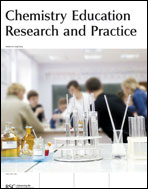Redox models in chemistry textbooks for the upper secondary school: friend or foe?
Abstract
We have investigated how chemistry textbooks use models of redox reactions in different subject areas, how they change models between and within the topics, and how they deal with specific learning difficulties identified in the literature. The textbooks examined were published for use in the natural science programme in Swedish upper secondary schools and in the UK A-level course. As a starting point, the defined redox models found in the literature were used to investigate the textbooks. The results show that all redox models are used with the addition of alternative representations. Authors exclusively use the electron and the oxidation number models in inorganic chemistry. In organic chemistry, the oxygen and hydrogen model are used, and in biochemistry mainly hydrogen and alternative representations. There is no guide to changes of models between the subject areas. However, within the inorganic chemistry, authors guide model change which was not identified in either organic or biochemistry. Regarding the learning difficulties, the authors dealt with just a few of them.

 Please wait while we load your content...
Please wait while we load your content...